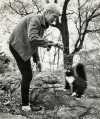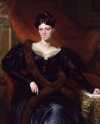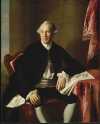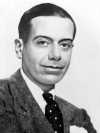.jpg) A prolific American artist and illustrator, Flagg designed 45 military posters during WWI, including the famous “I Want You” portrait of Uncle Sam. He studied abroad in England and Paris and, upon returning to New York, rapidly won a reputation as a technically skilled, versatile, and vivacious illustrator. Working in pen and ink, watercolor, and oils, he contributed to Judge, Life, St. Nicholas, and other magazines. On whose face did Flagg model his well-known Uncle Sam? Discuss
A prolific American artist and illustrator, Flagg designed 45 military posters during WWI, including the famous “I Want You” portrait of Uncle Sam. He studied abroad in England and Paris and, upon returning to New York, rapidly won a reputation as a technically skilled, versatile, and vivacious illustrator. Working in pen and ink, watercolor, and oils, he contributed to Judge, Life, St. Nicholas, and other magazines. On whose face did Flagg model his well-known Uncle Sam? Discuss
Source: The Free Dictionary
 Gounod was French composer who also studied for the priesthood and worked as an organist. Throughout his life, he remained torn between the theatre and the church. His reputation largely rests on his hugely popular 1859 opera, Faust, but he also wrote 15 lesser-known operas, 17 masses, more than 150 songs, and two symphonies. One of his short pieces, “Funeral March of a Marionette,” became well-known—albeit not by name—as the theme to what popular TV show beginning in the 1950s?
Gounod was French composer who also studied for the priesthood and worked as an organist. Throughout his life, he remained torn between the theatre and the church. His reputation largely rests on his hugely popular 1859 opera, Faust, but he also wrote 15 lesser-known operas, 17 masses, more than 150 songs, and two symphonies. One of his short pieces, “Funeral March of a Marionette,” became well-known—albeit not by name—as the theme to what popular TV show beginning in the 1950s?  Oates is an American author of over 50 novels and numerous volumes of short stories, poetry, and nonfiction. She has won the National Book Award and the O. Henry Award and has been thrice nominated for a Pulitzer. She writes about modern American life and the connection between violence and love. Her characters are mainly ordinary, inarticulate people to whom terrible things happen. Her most famous short story, “Where Are You Going, Where Have You Been?” is based on what real-life serial killer?
Oates is an American author of over 50 novels and numerous volumes of short stories, poetry, and nonfiction. She has won the National Book Award and the O. Henry Award and has been thrice nominated for a Pulitzer. She writes about modern American life and the connection between violence and love. Her characters are mainly ordinary, inarticulate people to whom terrible things happen. Her most famous short story, “Where Are You Going, Where Have You Been?” is based on what real-life serial killer? _by_Erling_Mandelmann_-_2.jpg) Italian comic book author Hugo Pratt spent his early childhood in Venice and moved with his parents to Ethiopia when he was 10. Following WWII, he returned to Italy, but he did not remain there for long. Pratt traveled widely, and his wanderlust is mirrored in his best-known character, Corto Maltese, a roving sea captain and adventurer. A meticulous researcher, Pratt often incorporated actual historic figures and events into Maltese’s fictional adventures. Where was Pratt imprisoned as a child?
Italian comic book author Hugo Pratt spent his early childhood in Venice and moved with his parents to Ethiopia when he was 10. Following WWII, he returned to Italy, but he did not remain there for long. Pratt traveled widely, and his wanderlust is mirrored in his best-known character, Corto Maltese, a roving sea captain and adventurer. A meticulous researcher, Pratt often incorporated actual historic figures and events into Maltese’s fictional adventures. Where was Pratt imprisoned as a child?  One of the original staff photographers at Time, Life, and Fortune magazines, Bourke-White was noted for her coverage of World War II. The first woman photographer to serve with US armed forces, she photographed the liberation of Buchenwald and was the only foreign correspondent in Moscow during the German invasion. Her pictures of the rural American South and her portraits of world leaders are also celebrated. What actress portrayed her in the movie Gandhi?
One of the original staff photographers at Time, Life, and Fortune magazines, Bourke-White was noted for her coverage of World War II. The first woman photographer to serve with US armed forces, she photographed the liberation of Buchenwald and was the only foreign correspondent in Moscow during the German invasion. Her pictures of the rural American South and her portraits of world leaders are also celebrated. What actress portrayed her in the movie Gandhi?  Rathbone was a British actor who made his film debut in the 1920s. With his distinctive voice and gaunt appearance, he was cast as a villain in several swashbuckling movies. He won praise for his roles in Romeo and Juliet and If I Were King, but he became best known for portraying Sherlock Holmes in a series of films beginning with 1939’s The Hound of the Baskervilles. Why did his English family have to flee South Africa when he was just three years old?
Rathbone was a British actor who made his film debut in the 1920s. With his distinctive voice and gaunt appearance, he was cast as a villain in several swashbuckling movies. He won praise for his roles in Romeo and Juliet and If I Were King, but he became best known for portraying Sherlock Holmes in a series of films beginning with 1939’s The Hound of the Baskervilles. Why did his English family have to flee South Africa when he was just three years old?  A chronically ill woman who lost her hearing in childhood, Martineau nevertheless went on to become a prolific and enormously popular English author. The sister of a minister, she first published articles on religious subjects, but it was her series of books on economics written for the layman that brought her renown. After a visit to the US in 1834, she became an abolition advocate and wrote several critical works on American culture. When she died in 1876, who wrote her obituary?
A chronically ill woman who lost her hearing in childhood, Martineau nevertheless went on to become a prolific and enormously popular English author. The sister of a minister, she first published articles on religious subjects, but it was her series of books on economics written for the layman that brought her renown. After a visit to the US in 1834, she became an abolition advocate and wrote several critical works on American culture. When she died in 1876, who wrote her obituary?  A Boston physician, Warren became a political leader in the American Revolution after the passage of the hated 1765 Stamp Act. In 1774, he drafted the Suffolk Resolves, which advocated forcible resistance to the British and were endorsed by the Continental Congress. In April of the following year, he dispatched William Dawes and Paul Revere to warn fellow patriots that the British were marching on Concord. He was killed months later at Bunker Hill. Why was his body buried four times?
A Boston physician, Warren became a political leader in the American Revolution after the passage of the hated 1765 Stamp Act. In 1774, he drafted the Suffolk Resolves, which advocated forcible resistance to the British and were endorsed by the Continental Congress. In April of the following year, he dispatched William Dawes and Paul Revere to warn fellow patriots that the British were marching on Concord. He was killed months later at Bunker Hill. Why was his body buried four times?  Lipinski is an American figure skater who, at the age of 14, won both the US and World Championships, becoming the youngest person ever to win either title. In 1998, she also became the youngest individual gold medalist in Winter Olympic history. Shortly thereafter, she launched her professional skating career, a move that was sharply criticized by some. The next year, she became the youngest person to win the World Professional Figure Skating Championships. Why did she stop skating in 2002?
Lipinski is an American figure skater who, at the age of 14, won both the US and World Championships, becoming the youngest person ever to win either title. In 1998, she also became the youngest individual gold medalist in Winter Olympic history. Shortly thereafter, she launched her professional skating career, a move that was sharply criticized by some. The next year, she became the youngest person to win the World Professional Figure Skating Championships. Why did she stop skating in 2002?  Though pushed by his grandfather to pursue law, Porter studied music at Harvard and in Paris. A gifted composer and witty lyricist, he wrote a dazzling series of successful film scores and Broadway musicals from the 1920s to the 1950s, including the musicals Anything Goes and Kiss Me, Kate. His most popular songs include “Night and Day” and “Let’s Do It.” A 1937 accident required him to undergo more than 30 operations, but he continued composing until 1958. Why did he stop?
Though pushed by his grandfather to pursue law, Porter studied music at Harvard and in Paris. A gifted composer and witty lyricist, he wrote a dazzling series of successful film scores and Broadway musicals from the 1920s to the 1950s, including the musicals Anything Goes and Kiss Me, Kate. His most popular songs include “Night and Day” and “Let’s Do It.” A 1937 accident required him to undergo more than 30 operations, but he continued composing until 1958. Why did he stop?